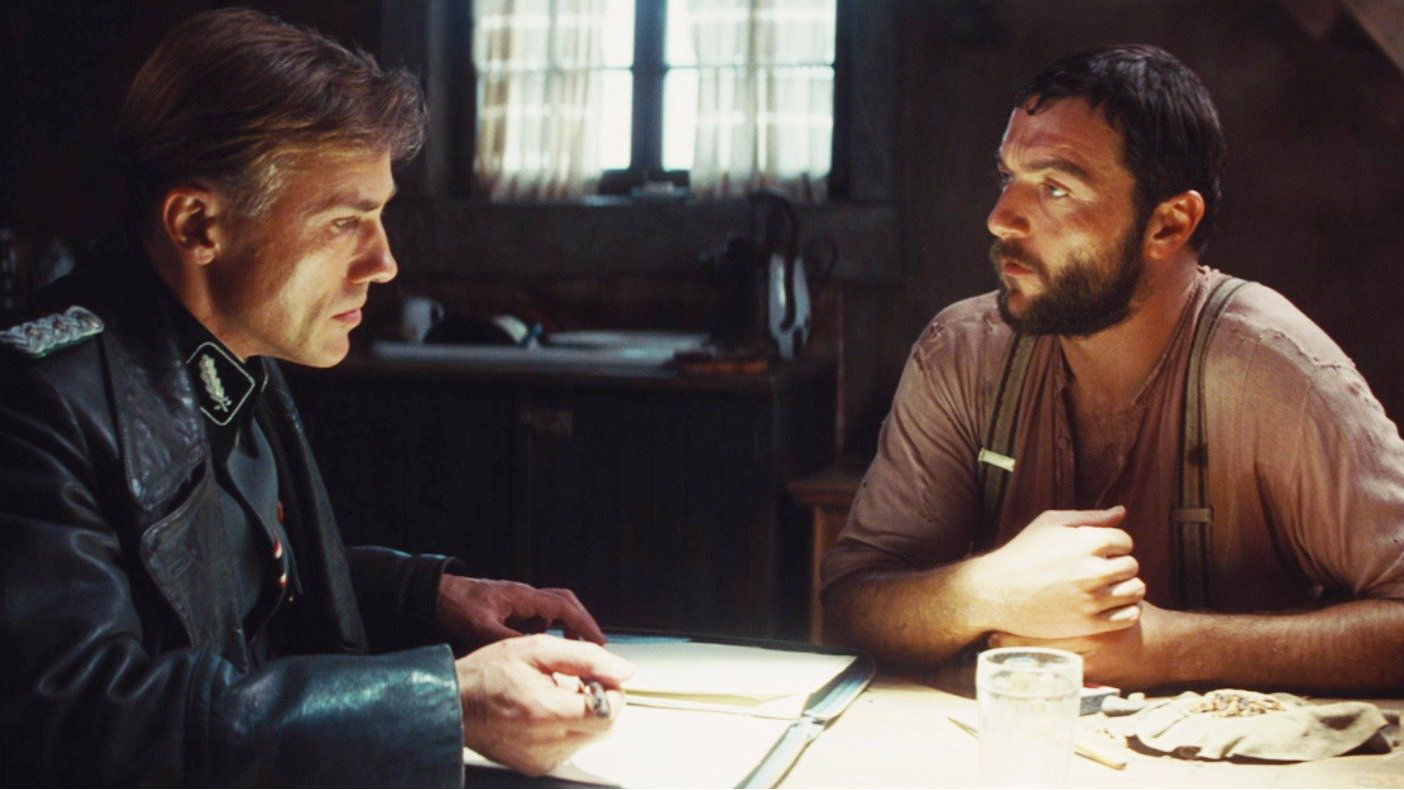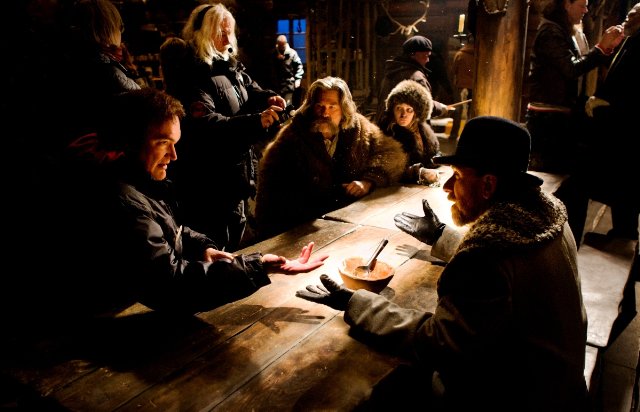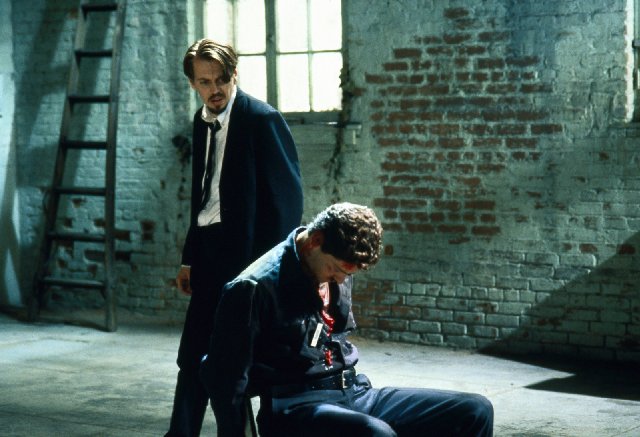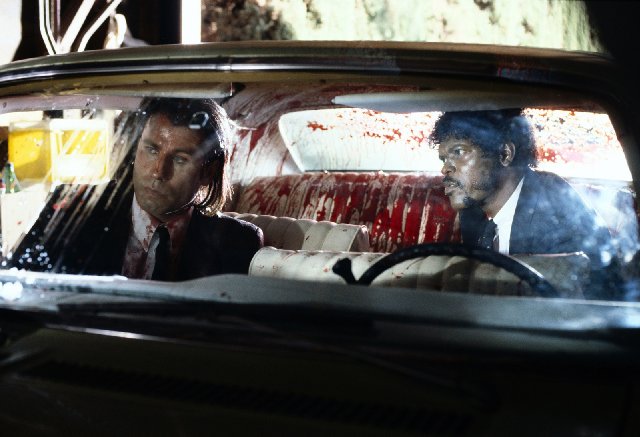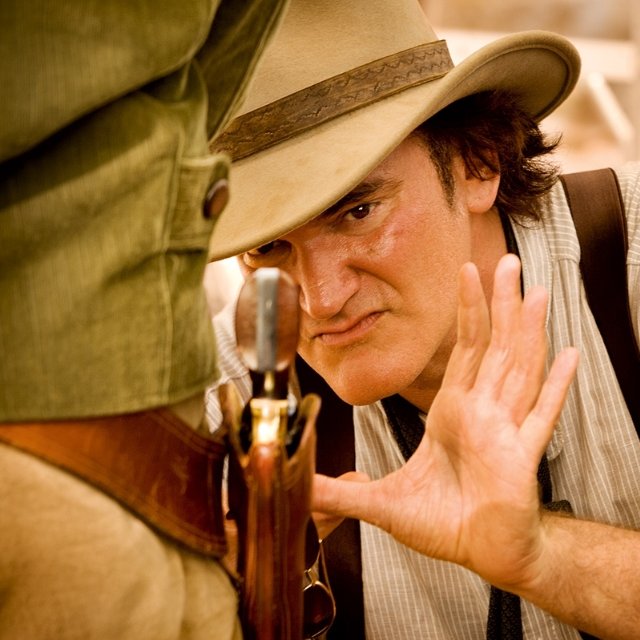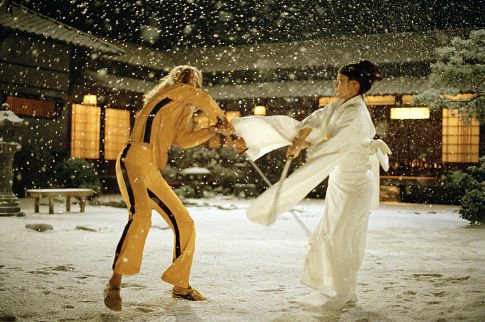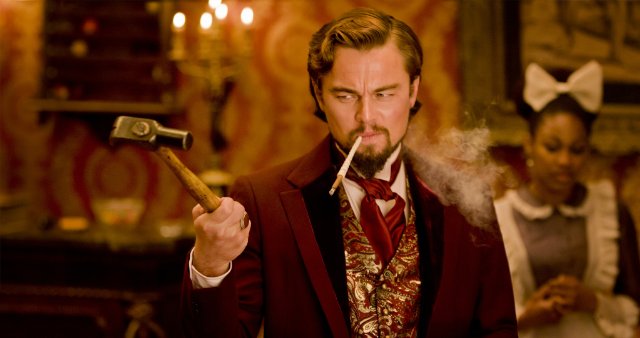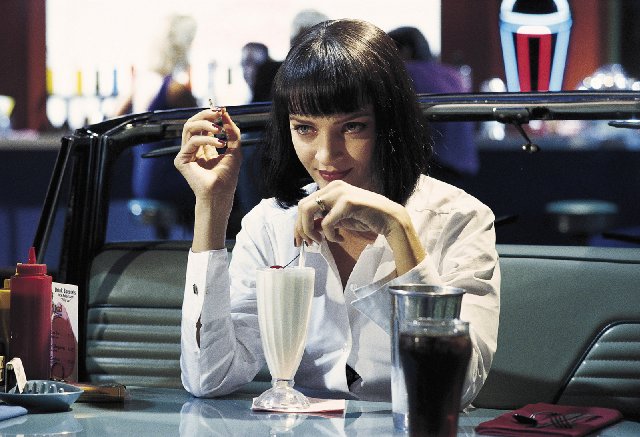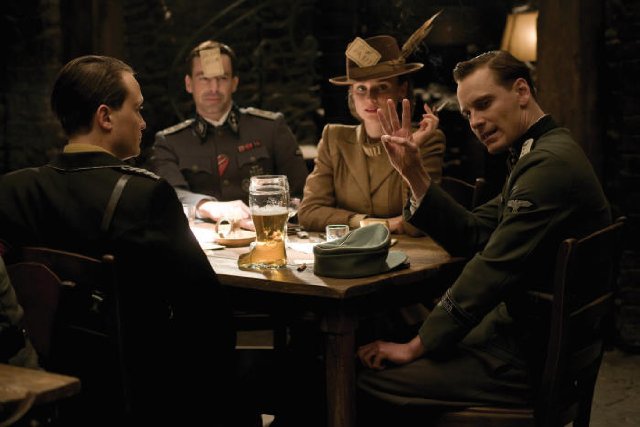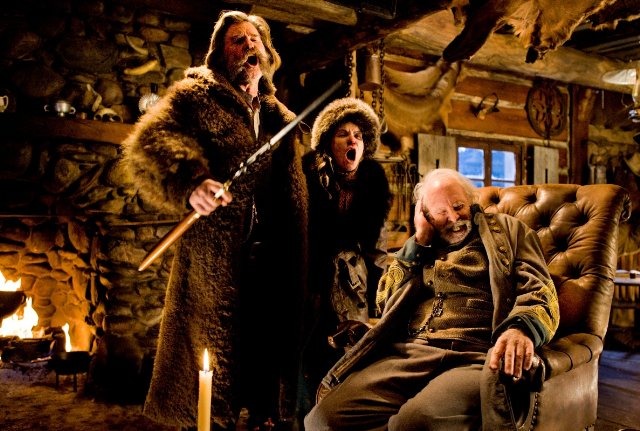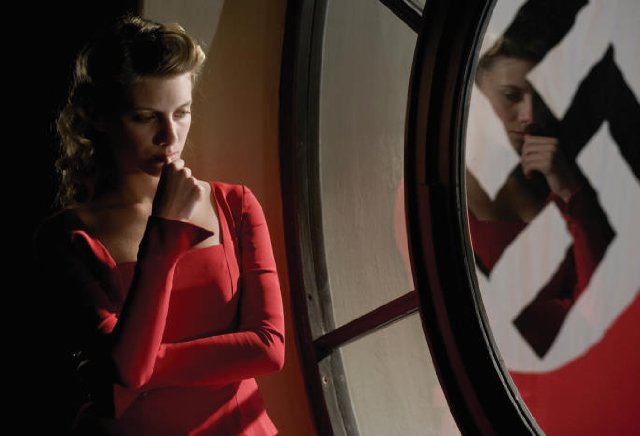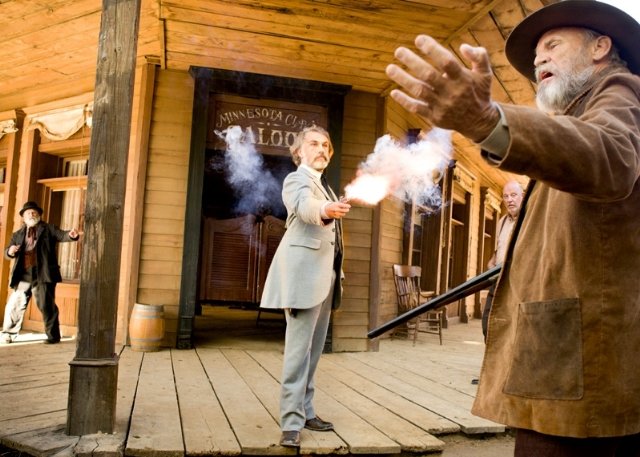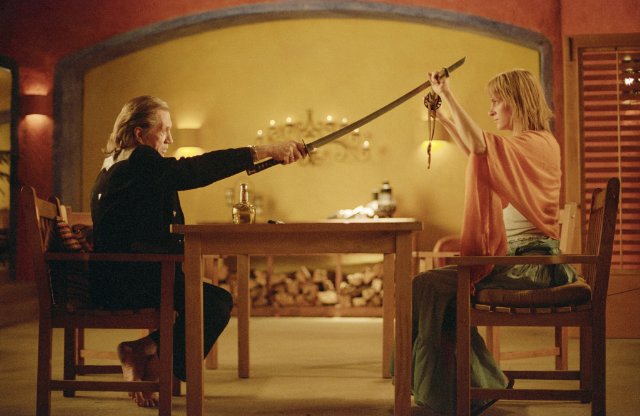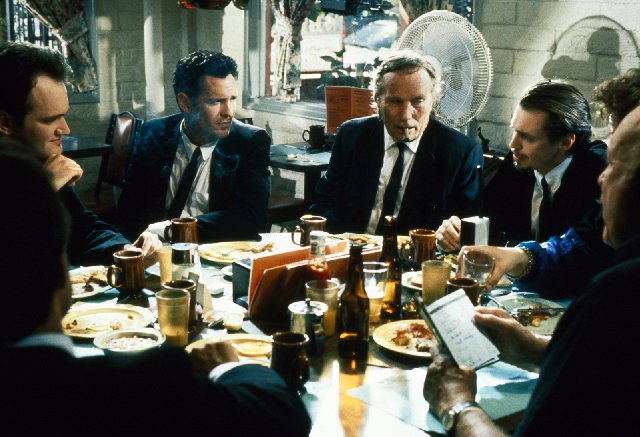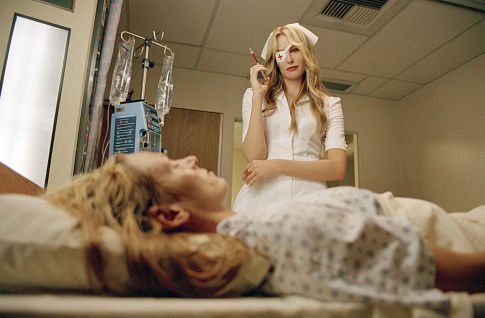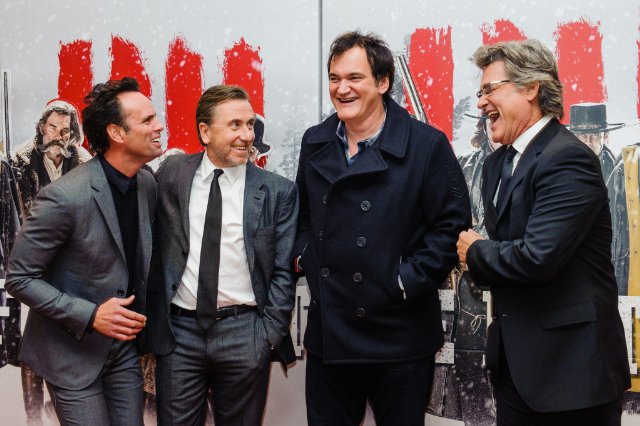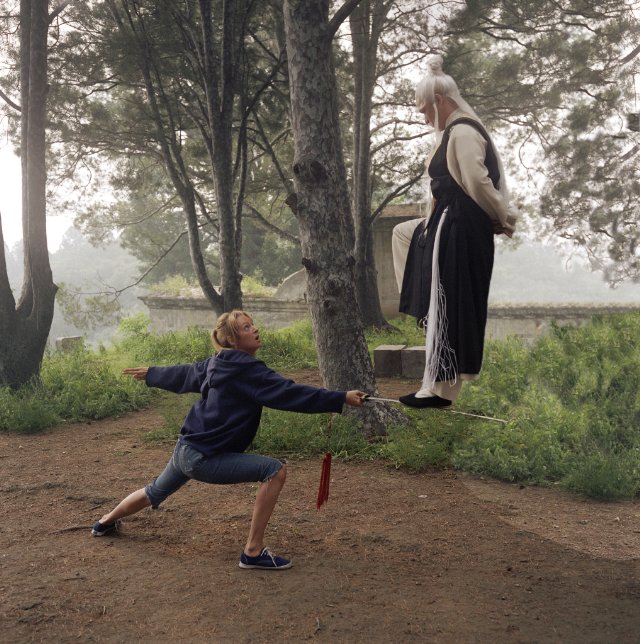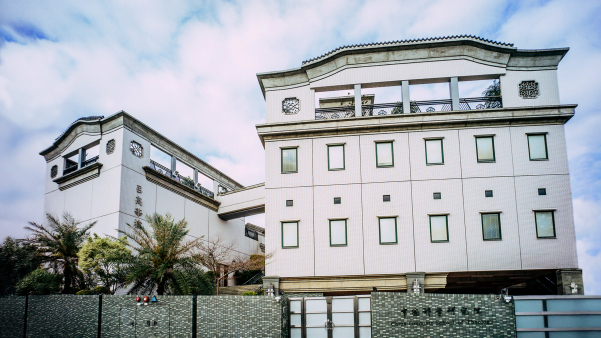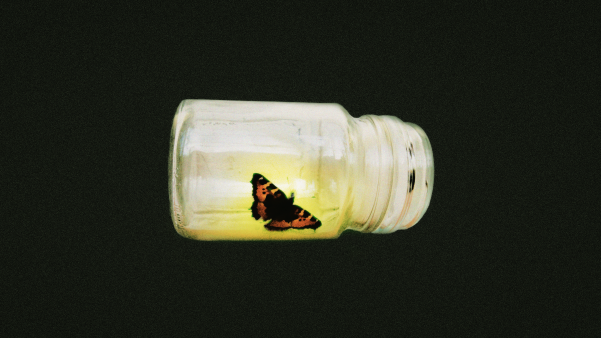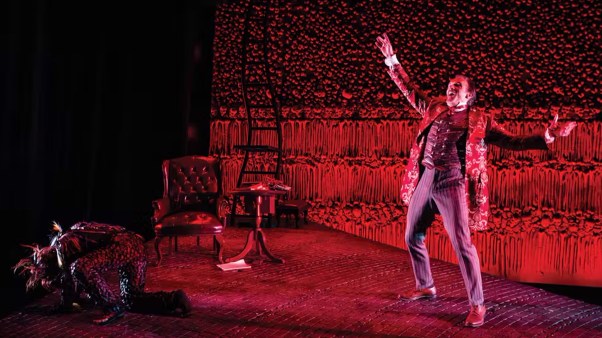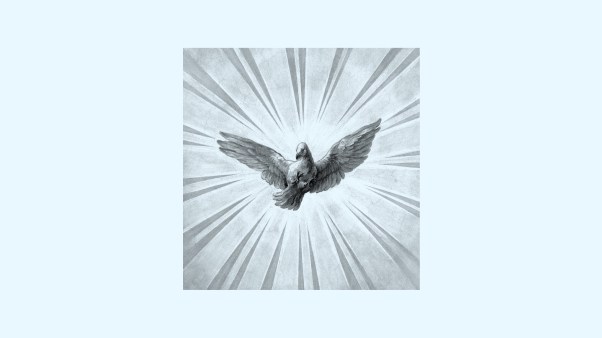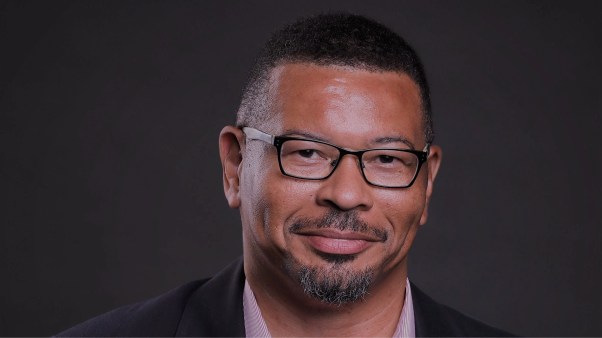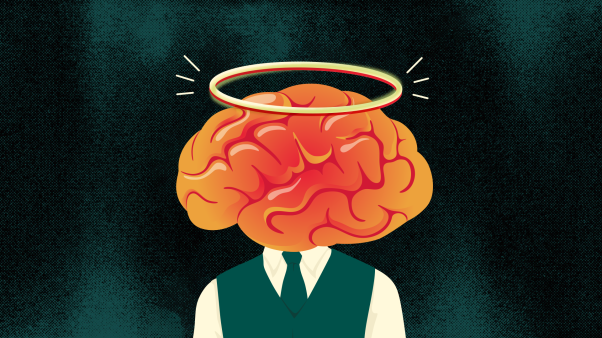This article is adapted from a chapter in the newly published book Tarantino And Theology.
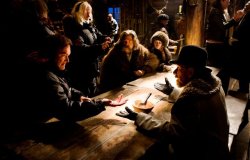 The Weinstein Company
The Weinstein CompanyThe Hateful Eight will be the second Quentin Tarantino film in a row to be released on Christmas Day (following 2012’s Django Unchained), a fact that probably has more to do with the lucrative holiday market than anything related to the significance of Christmas.
But what if Tarantino’s films actually do have something theological to say in this season of celebrating Christ’s Incarnation?
Tarantino is admittedly an unlikely contributor to the theology of Incarnation. But in their fixation on bodies (both fierce and frail), curious interest in food and drink, and focus on the sights, sounds, smells, and textures of the material world, Tarantino’s films represent an aesthetic that is distinctively “incarnational.” They help the viewer re-sensitize to the physical, fleshy world in which Christ lived, breathed, died and rose.
By paying attention to the incarnational aesthetics of Tarantino’s films, we push against the increasing disembodiment of our digital world, as well as our western Christian tendency to etherealize our faith, divorcing it from a material and embodied context.
Flying Limbs, Exploding Hearts, and The Centrality of the Body
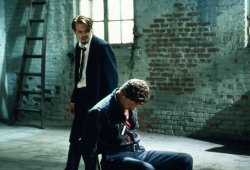
One of the things that makes Tarantino films so simultaneously compelling and horrifying, so “can’t-turn-away” attractive and “I-have-to-close-my-eyes” repulsive, is the director’s skill at visceral communication of human embodiment.
His heroes and villains are full of life: they are quick with their hands, expressive with their eyes, clever in their speech and lethal in their skill with samurai swords, baseball bats, shotguns, and bare knuckles. And yet unlike the super-human heroes and villains of much of Hollywood fiction, Tarantino’s characters are also decidedly mortal. They bleed, they groan, they die. And they do so frequently in his films.
For almost the entirety of Tarantino’s first film, Reservoir Dogs (1992), the breakability of Mr. Orange (Tim Roth) is on shocking display as he bleeds, wheezes, cries, squeals, and squirms in gruesome agony—in the backseat of a car at first, and then on a warehouse floor. As he bleeds from the stomach and writhes on the floor, others suffer around him, including a hostage cop who is tortured and killed in what became the film’s most controversial display of violence.
Bodies undergo a lot in Tarantino films. Limbs are frequently severed and maimed victims left convulsing and screaming in pain (see the “House of Blue Leaves” sequence in Kill Bill Volume 1); legs are severed and fly through the air like projectiles (see the car crash scene in Death Proof); bones are viciously broken (the mandingo fighting match in Django Unchained); eyeballs squished and hearts exploded (Kill Bill Vol. 2); heads scalped, carved, or bashed in via baseball bat (Inglourious Basterds), and so on.
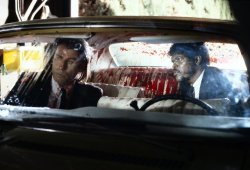
The explicit carnage and creative array of injuries inflicted on bodies in the Tarantino oeuvre is more than a shock-tactic or trademark, however. It’s certainly up for dispute, but I don’t believe that Tarantino is a sadist or bloodthirsty lover of violence for its own sake. Rather, I believe that the director recognizes that the human body is innately dramatic, charged by the reality of its vulnerability. Without the ever-present possibility of injury or death, there would be no drama. No fight. No stakes.
Tarantino uses violence—even foregrounds it via exaggeration (“spray blood”)—because he wants the audience to feel uneasy and squeamish about the reality of embodiment — at once a glorious and tenuous thing. Our heart rate rises, we wince, our white-knuckled fingers cover our eyes, because we see our own contingency in that of these characters.
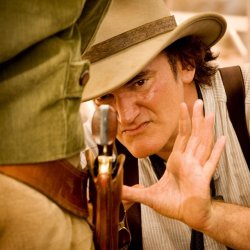 Andrew Cooper / The Weinstein Company
Andrew Cooper / The Weinstein CompanyWhereas in most Hollywood action films the protagonists are almost universally invincible (see the filmography of Steven Seagal or Sylvester Stallone), surviving all manner of violence, time and time again, with nary a scratch or broken bone, the survival of Tarantino’s heroes is never a given. In Inglourious Basterds, several sympathetic characters are shown to be skilled survivors and yet don’t survive to the end of the film. Killing machine Stiglitz (Til Schweiger), British spy Archie Hicox (Michael Fassbender), even heroine Shoshanna (Melanie Laurent) are no match, in the end, for the lethal force of a few bullets. In Django Unchained, bounty hunter protagonist Dr. Schultz (Christoph Waltz) is also killed off by an unceremonious shotgun blast near the end of the film.
Even when Tarantino’s characters seem super-human in their skill with weaponry and bad-guy thwarting, they are revealed to be decidedly breakable and prone to the same pangs of embodiment as the rest of us. Django (Jamie Foxx) is incredibly vulnerable at various points in Django Unchained. As the film opens he is in chains as a slave, ankles bloodied and whip scars all over his back. Later in the film he is hung naked, upside down, captive of one of Calvin Candie’s henchmen.
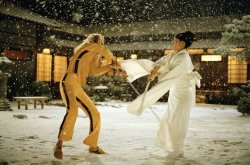 Andrew Cooper / Miramax Films
Andrew Cooper / Miramax FilmsUma Thurman’s character (The Bride) in Kill Bill is arguably the fiercest, most powerful figure in any of Tarantino’s films. And yet even she has a body that is easily broken. As Vol. 1 opens we see a close-up of her bloodied, beaten face, before she is shot at point blank range and left for dead. We then see her wake up from a four-year coma, struggling to regain movement in her atrophied legs and feet. In Vol. 2 we again see her shot and left for dead, this time buried alive in a wooden casket. The agonizing, claustrophobic scene once again shows her body’s vulnerability. She screams, cries, kicks and writhes in the confined space, ultimately punching her way out (though not without bloodying her knuckles).
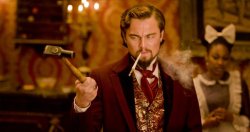 Andrew Cooper / The Weinstein Company
Andrew Cooper / The Weinstein CompanyTarantino’s insistence on the vulnerability and mortality of his characters is just one aspect of his high view of human embodiment. The director’s camera also focuses quite a bit of attention on the movement, gestures, and mannerisms of his characters. Whether it’s the walking of Pam Grier at the opening of Jackie Brown (1997), the famous dance scene between Uma Thurman and John Travolta in Pulp Fiction, or the way Calvin Candie (Leonardo DiCaprio) holds a cigarette in Django Unchained, Tarantino seems to relish the way his actors embody their characters. His films are always full of close-ups on faces, and frequently on hands and on feet.
You’ll also notice that a preferred camera vantage point in Tarantino films is from below, looking up at characters looking down. From this perspective, actors loom large in the frame, appearing imposing, powerful, dominant. It’s a visual way of communicating the grandeur of the human form, while also hinting at its ever-present vulnerability (as when we’re looking up at Samuel L. Jackson and Chris Tucker from the perspective of a car trunk in Jackie Brown, followed soon after by Jackson’s unceremonious killing of Tucker).
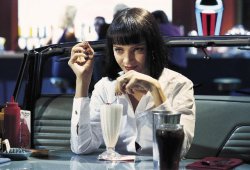
In all of this, Tarantino is establishing a decidedly incarnational aesthetic. He is at least as interested in the embodiment and fleshiness of his characters as he is with what they say and the ideas they espouse. Even in their dialogue with one another, which often dominates long, 10-20 minute stretches of his films, Tarantino seems less interested in the substance of what they are discussing (which is often random and mundane, and only about plot exposition when necessary) than with the fact that they are discussing. Talking is something humans do. It is the chattiness itself that seems more interesting to Tarantino that the topics of chatter.
Tarantino’s films celebrate the humanness of humanity: the way we talk, move, dance, fight, sweat, bleed, and die. And also the way that we eat.
“Royale With Cheese”: Food in the Films of Tarantino
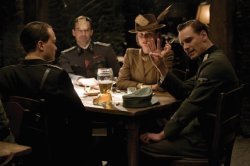
Food and drink are noticeably present in the films of Quentin Tarantino, and they often establish themselves very early on in the films. The opening scenes of both Reservoir Dogs and Pulp Fiction open in diner-type restaurants, with characters dialoguing over coffee, beer, and breakfast. The memorably tense opening scene of Inglourious Basterds features the most ominous milk drinking in the history of cinema, followed later by the white-knuckle scene of Shoshana and Hans Landa eating a delicious looking apple strudel with cream.
Who can forget the famous dinner scene in Pulp Fiction, at “Jackrabbit Slim’s,” where John Travolta and Uma Thurman order menu items like the Douglas Sirk steak (prepared “bloody as hell”), the Durwood Kirby burger, and the $5 Martin and Lewis shake? Or the climactic encounter between The Bride and Bill in Kill Bill Vol. 2, which prominently features Bill making a sandwich, complete with mayo, mustard and Bimbo bread sans crust? Or the fabulously wrought tavern scene in Inglourious Basterds, where beer, biersteins, and bubbly abound?
It’s one thing to include food as a prop in a film; almost every film has it somewhere, usually sitting on tables uneaten during dialogue scenes. But Tarantino’s camera takes special notice of food. It pauses for a close-up on the delectable apple strudel and then pauses again when the waiter plops a dollop of cream on it. In Jackie Brown the camera takes special notice of coffee being poured into a mug. In Django the camera takes a moment to zoom in on Dr. Schultz pouring a golden, refreshing looking draft beer and then scraping off the excess head.
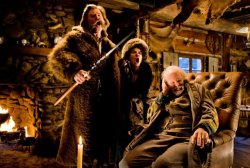 The Weinstein Company
The Weinstein CompanySometimes food is just a conversation piece, as in the famous “Royale with Cheese” dialogue scene between Jules (Samuel L. Jackson) and Vincent (Travolta) in Pulp Fiction. Other times it is a character’s trademark, as in Ordell’s cocktail of choice (the screwdriver) in Jackie Brown, or Calvin Candie’s white cake and coconut cocktail, or Stuntman Mike’s greasy nachos in Death Proof. Frequently food is associated with the unique ethnicity or piece of pop culture being mined at the moment: sushi in the Tokyo sequence of Kill Bill Vol. 1; rice during the Pai Mei training sequence in Kill Bill Vol. 2; apple strudel with the Nazis and 33-year Scotch with Lt. Hicox in Inglourious Basterds; sweet tea and bourbon cocktails in Django Unchained; and so on. Food is a vivid, sensuous part of culture, and Tarantino loves culture.
The Colors and Cultures of the World
In addition to the prominence of the body and the prevalence of food, another aspect of Tarantino’s incarnational aesthetic is the director’s general interest in visuals, color, buildings, costumes and characters that reflect the vibrancy and diversity of human culture.
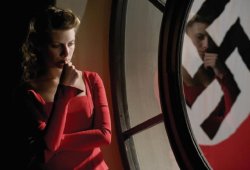
One way this is expressed is simply the ubiquity of literal color in Tarantino’s films. It’s everywhere. The man loves primary colors especially, whether yellow motorcycles (Kill Bill Vol. 1), bright blue flight attendant uniforms (Jackie Brown), or red dresses (Inglourious Basterds) and (of course) flowing red blood. As if the colorful walls, cars, and costumes weren’t enough, Tarantino also gives his characters and settings colorful names: Misters Brown, Blonde, Pink, White & Orange in Reservoir Dogs, Vernita Green and the House of Blue Leaves in Kill Bill Vol. 1, and then, of course, Jackie Brown.
“Color” also manifests itself in the diversity of ethnicities and nationalities represented. In the same way that Tarantino’s films are each a pastiche of genres and pop culture anachronisms, they are also mosaics of race: Caucasian, Asian, African, Hispanic, Jew, Gentile, European, American, and so on. Tarantino makes a point of rendering this diversity in sharp relief. In Kill Bill Vol. 1 he calls attention to O-Ren Ishii’s half-Japanese and half-Chinese background, as well as Sophie Fatale’s French/Japanese heritage.
In Inglourious Basterds he exaggerates the Britishness of his British characters (see Mike Myers and Michael Fassbender in the “Operation Kino” briefing scene), the French-ness of his French characters (see cinephile Shoshana looking bohemian while reading and smoking in a Paris café) and the German-ness of his German characters (see the sloshy beer-drinking of the Nazis in the Tavern scene). Tarantino’s characters names also reflect this celebration of culture at its most whimsically exaggerated.
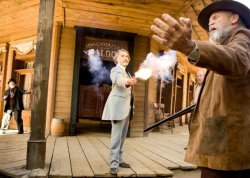 Andrew Cooper / The Weinstein Company
Andrew Cooper / The Weinstein CompanyYou can almost smell the magnolia blossoms in a Southern belle name like Lara Lee Candie-Fitzwilly (Django), and you can almost picture the dirndl dress and blonde braids in a Bavarian name like Bridget von Hammersmark.
Tarantino’s globetrotting films relish the anthropology of place, even if it is “place” as filtered through the fantasies and genres of cinema and pulp fiction. His films are about Los Angeles through the lens of hardboiled crime novels and 1950s Hollywood; Tokyo through the lens of anime, samurai and yakuza crime films; Europe through the lens of spy and war films; the American frontier as filtered through John Ford and Spaghetti westerns, and so on. It’s not that Tarantino isn’t enamored with the places & culture themselves; he is. But he’s even more enamored with the way that cinema has explored, exaggerated, remixed and mythologized them.
Tarantino’s love of place and culture also manifests itself on a more material level in his love of buildings, production design and memorable set pieces. The director’s preference for episodic narrative lends itself to the building of elaborate scenes and sequences (or “chapters” as he often calls them) that are supported by the scaffolding of memorable physical spaces. From Pulp Fiction we vividly remember the bright colors and Hollywood pastiche of Jackrabbit Slim’s; from Inglourious Basterds we recall the “Operation Kino” tavern and the movie theater that is the setting for the film’s explosive climax. In Django we have the epic “Candieland” plantation where the final 50 or so minutes of the film plays out (before being spectacularly blown to smithereens).
 Miramax
MiramaxIn a manner similar to that of Wes Anderson, Tarantino often takes time to “explore” the spaces of these set pieces with his camera floating through walls, above ceilings and below floors to immerse the viewer in the space. In the House of Blue Leaves in Kill Bill Vol. 1, Tarantino establishes the space at length by following various characters around, giving us a tour of the Japanese restaurant/bar before the bloodbath begins. A similar thing happens in the climactic chapter of Inglourious Basterds when Tarantino’s camera watches Shoshana put on her makeup and then (from above) sees her walking from her apartment out to the balcony overlooking the foyer bustling with doomed Nazi revelers.
Whether it be Col. Sanders white suits, cotton fields and Spanish moss paying homage to the Antebellum South, the music of Ennio Morricone celebrating Sergio Leone spaghetti westerns, or prolonged car chases glorying in 1970s grindhouse cinema, Tarantino’s films are full of a vibrant, exuberant embrace of the eccentricities and diversities of human culture.
More than just a celebration of pastiche, reflexivity and irony, Tarantino’s films are earnestly in love with the quirks, colors, songs, sayings, celebrities, superheroes, myths, histories and imperfections of man. In this they are deeply humane, grounded in the messiness of life, death, and everything in between.
Towards an Incarnational Aesthetic of Cinema
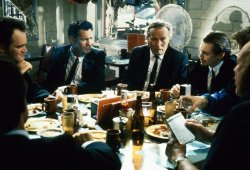
The Christian theology of the Incarnation begins with the notion that Jesus Christ, as the second person of the Trinity, became flesh when he was born of the Virgin Mary. It’s the idea that Jesus Christ was fully divine but also fully human. He wasn’t just an ethereal deity or super-human God-man. He sweat, bled, talked, walked, cried and yelled like the rest of us. He experienced pain. He died a brutal, bloody death, agonizing in pain throughout the torture and execution, just like so many Tarantino characters do.
Also like so many Tarantino characters, Jesus ate and drank. He “came eating and drinking,” notes Luke 7:34. Jesus was also a cultural being. Just as he did not shun his embodiment; nor did he downplay his culture. Throughout his ministry he incorporated cultural tropes, symbols and references in his parables and teachings.
What this means for Christians is that the world—in all its muddy, harsh, jagged physicality and cultural color and oddity—is not just kindle for an eventual fire; it’s the chosen medium of God’s revelation. In Christ, God came to meet us on our own turf. He ate our food, suffered the same temptations, thirst after the same water as he toiled under the same sun.
So what, then, might an “incarnational aesthetic” look like in cinema? I think the aesthetic of Quentin Tarantino gets pretty close.
 Andrew Cooper / Miramax Films
Andrew Cooper / Miramax FilmsIn labeling Tarantino’s films “incarnational,” the question of whether or not Tarantino believes in Jesus Christ’s physical life, ministry, and death is secondary to the fact that his view of the world is decidedly sacramental.
As we have seen, his cinema embraces the fleshiness of flesh, the embodiment of bodies (both at their most magnificent and frail), the intensity of man’s contingency, the glories of quotidian life (namely eating and drinking), and a visceral manifestation of the colors, rituals and icons of culture.
Some might argue that Tarantino’s films are more about artifice than realism, which may very well be true. The exaggerated violence (does anyone bleed like Sophie Fatale bleeds when her arm is cut off in Kill Bill Vol. 1?) and over-the-top pop culture pastiche often evokes a world that feels more like a celebration of movies than a celebration of life. But even a slightly off-kilter, hyperbolized world can still be a visceral expression of the humanness of humanity and the vibrancy of culture.
Even though we know Tarantino’s films are fake (they often call special attention to their fakery), they still pack a physical punch: they get our blood boiling, our heart racing, our senses heightened. Why? Because they understand cinema’s unique power to zoom in on the incarnate wonders and horrors of this life.
Other films and filmmakers embrace cinema’s artifice and yet fail to engage the bodily senses in the way Tarantino does. Advances in technologies such as CGI (computer-generated imagery) have allowed filmmakers to create “more realistic” things like explosions, dinosaurs, aliens, robot war machines, and cities being obliterated by some combination of natural disasters or man-made carnage.
Yet ironically, CGI further distances the viewer from the real-ness of reality and drains cinema of its visceral power. Granted, CGI has made large-scale fantasy and superhero action films possible (see Peter Jackson’s Lord of the Rings or Joss Whedon’s The Avengers), and many of those films have done a fair job balancing in-the-flesh action with CGI theatrics.
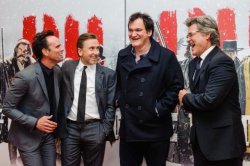 Dave J Hogan
Dave J HoganBut in general, CGI creates unnecessary and distracting fakery that saps a film of its incarnational beauty. It’s one thing for filmmakers to use CGI to render creatures that do not exist in reality (dragons, dinosaurs, King Kong, whatever that beast-out-of-the-sea was in Cloverfield); but why create CGI versions of things that do exist, such as deer (see I Am Legend), gophers (see Indiana Jones and the Crystal Skull) or humans (see The Matrix: Reloaded)?
Celebrating fantasy and artifice is fine, but why not use flesh-in-blood actors, real-life built sets, makeup, costumes, and good-old-fashioned fake blood rather than digital replicas? Tarantino goes this route, and his films are better for it.
“The only time you’re allowed to use CGI,” noted Tarantino in a 2013 interview with the Daily Mail, “is where you would kill the actor if you did the stunt for real. Otherwise, if you want to impress me as a viewer, you’ve got to do it.” Tarantino goes to extremes to ensure the “realism” of the action he is shooting, such as famously shooting the high-speed climactic chase in Death Proof with stuntwoman Zoe Bell on the roof of the car for real. In Django Unchained, for example, Tarantino went to extremes to capture the coldness of the wintertime opening sequence:
I needed it to be so cold you could see the actors’ breath; I didn’t want to add the breath later. It was -8F. People were collapsing, going face down in the snow. People would start crying and were having nervous breakdowns because it was so brutally, frigidly cold. But if I can shoot the real thing, I will.
Tarantino’s insistence on going to great lengths to shoot things “for-real” may likely be more time-consuming, expensive, and rigorous for actors, but it pays dividends in its affective force on the viewer. Tarantino’s sweaty, bloody, bone-crunching foregrounding of embodiment is far more riveting to watch than the “dead-eye” characters of CGI action getting battered in digitally-altered ways (see Avatar, or almost everything Zack Snyder has directed).
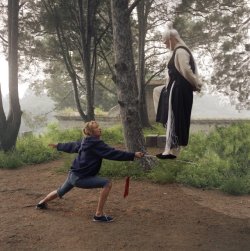 Miramax
MiramaxPerhaps the “incarnational” aesthetic of Tarantino’s cinema is a style that our increasingly disembodied, digitized world needs more than ever. At a time in history when formerly ubiquitous artifacts of analog culture (books, handwritten letters, physical music records, to name a few) are rendered obsolete, when face-to-face, incarnational community is being replaced by screen-to-screen communication, and when globalization continues to erode cultural specificity, Tarantino fights tooth-and-nail to preserve the irreplaceable beauty of life incarnate. His cinema rattles us, shakes us, sensitizes us to the glories of the fleshiness of flesh and the earthiness of earth.
For Christians—who have sometimes been prone to Gnostic tendencies to deemphasize the body and its attendant this-worldly habitats and cultures—the incarnational aesthetic of Quentin Tarantino is a helpful reminder that medium and message are intimately linked. And in the case of the gospel we profess, the medium is material: a physical man who entered a dusty, rocky terrain; who ministered to others around tables with fish, bread and wine; whose body was broken, battered, buried and ultimately resurrected; and who lives today not in philosophical ideas or discourse but in the lives of his human followers, the church, the body of Christ.
Brett McCracken regularly writes about film and culture for CT. This article is adapted from a chapter he contributed to the newly published book Tarantino And Theology. Follow Brett on Twitter @brettmccracken or at brettmccracken.com.

